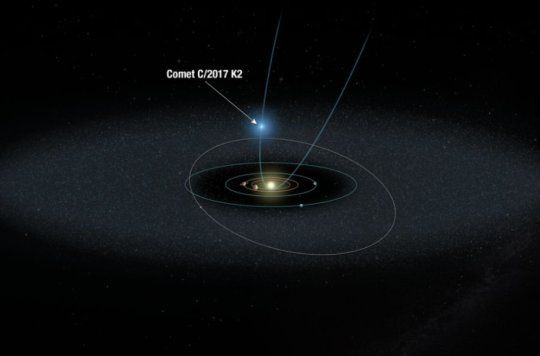NASA's Hubble Photographs Farthest Active Inbound Comet From Oort Cloud

NASA has photographed the farthest active comet entering the solar system, at a whopping distance of 1.5 billion miles from the sun.
The Hubble Space Telescope captured an image of C /2017 K2 (PANSTARRS) or "K2," which has been flying towards us for millions of years from the icy exteriors of the solar system.
The comet was captured as it was entering the solar system’s planetary zone, and was seen along with an estimated 80,000-mile-wide fuzzy cloud of dust known as a coma.
The coma engulfs a tiny ball of frozen space dust and gases. It has been theorized the coma is caused by the heat of the sun as the comet hurtles toward it.
Scientists who studied the orbit of K2 have concluded that it originated from a region in space known as the Oort Cloud.
This area almost a light year in diameter is said to be home to at least a hundred billion comets. These comets are left-over floating space matter from the formation of the solar system. They date back 4.6 billion years and are made up of fascinating ice that is very pristine and old.
"K2 is so far from the Sun and so cold, we know for sure that the activity, all the fuzzy stuff making it look like a comet — is not produced, as in other comets, by the evaporation of water ice," said lead researcher David Jewitt of the University of California, Los Angeles.
The team thinks that it is because of sublimation, whereby a solid substance directly changes into gas. Here, super-volatile materials in the comet convert to gas.
Sunlight heats up gases on the comet's surface and the oxygen, carbon, nitrogen and carbon-dioxide fly off it. This forms the dust which makes up the coma. The comet originated in a region where temperatures are minus 440 degrees Fahrenheit. When the comet encounters even a little radiating heat from our distant sun, it sets off the sublimation.
This coma is what makes this comet special. Previously, scientists had only observed comets much closer to the sun. The volatile particles on a comet are isolated from the surface. When the comet starts entering the solar system, it starts burning off this volatile material.
Up until now, we had observed comets that had already ‘shed’ its volatile layer. Though these volatile particles are found on every comet in the Oort Cloud, it hadn’t been observed before. The visible coma from the comet is proof that this is the oldest one observed, the team said.
The use of Hubble’s sharp eye helped the team study the coma in detail. It also helped calculate the size of the nucleus of the comet, which is less than 12 miles long. The coma was estimated to be 10 times the diameter of Earth.
"We think the comet has been continuously active for at least four years," Jewitt said in the report by Science Daily. "In the CFHT data, K2 had a coma already at 2 billion miles from the Sun, when it was between the orbits of Uranus and Neptune. It was already active, and I think it has been continuously active coming in. As it approaches the Sun, it's getting warmer and warmer, and the activity is ramping up."
Studying this comet as it progresses through our solar system will help us understand specific characteristics of comets from the Oort Cloud area. With a number of comets cantering out of the Oort Cloud, understandin them could give us key clues about the early solar system.
© Copyright IBTimes 2024. All rights reserved.




















